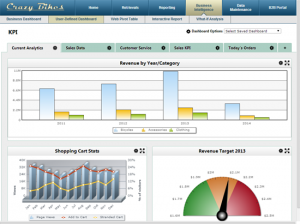 Summary: Poised for rapid growth, Business Intelligence is also on the verge of some major changes. Driven in part by recent trends and development advances, the BI of the near future will shift dramatically from traditional BI solutions of the past. In this article, you’ll learn more about why BI is changing and where it’s heading.
Summary: Poised for rapid growth, Business Intelligence is also on the verge of some major changes. Driven in part by recent trends and development advances, the BI of the near future will shift dramatically from traditional BI solutions of the past. In this article, you’ll learn more about why BI is changing and where it’s heading.

Additionally, while we stand on the verge of a BI explosion, we’re also seeing significant changes. Mobile technologies have improved. The cloud has grown into a viable business option. Increasingly powerful web development technologies open new opportunities. These trends, among others, are leading to the next wave of BI.
So, where is BI heading? Today, let’s take a look at what’s in store for the next year. What big BI trends can we expect in 2014, or the early part of 2015? Which areas of BI will grow in the coming year? We posed those questions to a few experts in the area, and have compiled their thoughts (along with some of my own) below. Here are 7 big BI trends to watch in 2014:
1. BI adapts to a multi-screen world
“There is increasing demand on mobile BI,” says Kiran Nandavarapu, Senior Manager with Blueocean Market Intelligence. “However, the market is still debating how to deliver mobile, what capabilities to offer, and which devices to support. And despite all the hype, mobile is still something BI teams have to push users to embrace.”
Despite the web’s social nature, Business Intelligence software remains largely “un-social.” While we see collaborative features increasing within BI software, this study from Dresner Advisory Services finds that BI collaboration still largely occurs the old-fashioned way–via meetings and email. As companies seek to gain more value from their data, we’ll see this change. We’ll see more social features invade traditional BI software, with collaboration occurring within the BI application rather than email and meetings. One of the biggest problems with traditional BI solutions: Silos. Different departments store data in different systems, which leaves business leaders trying to make sense of different data from different sources. Going forward, we’ll see a convergence in BI, giving executives the data they need from a single source.
BI solutions of the past provided a reactive approach–offering historical analysis of business data on a weekly, monthly, or yearly basis. While useful for understanding the business, reactive BI doesn’t capitalize on the rise of real-time data. As more companies adopt real-time analytic solutions, we’ll see a rise in proactive BI. This approach alerts users to important data changes as they happen, and lets business leaders make quick, yet informed decisions. For example, we’ll see more BI solutions that automatically alert business leaders to real-time, dramatic shifts in data. This proactive approach will help businesses become more agile, and address problems as they occur–not days later. Traditional BI methods involved end users going through the IT department for reports and analytics, or creating their own reports on spreadsheets. As BI tools become simpler, we’re seeing that change. BI is moving outside of the IT department and into the hands of business users–creating a rise in BI efficiency.
“Self-service BI equips users with direct access to business data and empowers them to collect and analyze data independent of the IT department,” explains Tiemo Winterkamp, Senior VP of Global Marketing at arcplan. “With modern tools users can create dashboards and ad-hoc reports on their own, something that was previously only possible with the aid of IT specialists. Using self-service capabilities, organizations allocate resources wisely by providing information workers with a guided analytics approach to BI. Self-service BI paves the way for workers to be autonomous, thereby improving productivity and increasing the efficiency of business processes. With this business impact, this trend will continue to grow in 2014 and beyond.”
As self-service BI grows, software must become simpler. It must display data in a way that’s easily understandable for anyone–not just data scientists. For this reason, we’ll see BI solutions provide improved data visualizations for all user levels.
“In fact, my report shows that the most requested business intelligence applications from buyers right now are customizable dashboards and scorecards. While current BI users are generally satisfied with their reporting capabilities, they want to better visualize the data they are collecting. Buyers want a BI tool that can pull data from their existing systems into an attractive, informative, easy-to-understand dashboard. This also points to the awakening of non BI professionals to the decision-making support of business intelligence and the growing desire to harness its insights for unique, company-specific information in a clear way.”
While cloud-based BI certainly isn’t new, we’ll see significant growth this year. As data volume grows, managing that data in-house becomes more challenging. The pain of maintaining infrastructure combined with the growing maturity of the cloud will result in more businesses moving their BI to cloud services.
“The initial apprehensions around the reliability, safety and sustainability of cloud computing are slowly fading away, and companies are increasing their overall spend on cloud infrastructure,” explains Nandavarapu. “The intersection of analytics and cloud is creating new value and means to exploit Big Data. Cloud versions of BI software will rise in 2014 due to various benefits it provides such as ease of use, flexibility, reduced costs, lower implementation time and faster ROI.”
So, what do you think? Is there anything you would add to this list? If so, please share your thoughts in the comments.
3. BI breaks out of the silos

4. BI becomes proactive
5. Self-Service BI improves efficiency
6. Data visualization improves

7. Cloud-based BI grows
You missed out a big one – Data Warehouse Automation! (Information Management have it in their top-ten for this year!) 😉
Pingback: Apple's "Dangerous Game" and Mobile BI | Flex.io
It’s really a great pleasure to provide an opinion about ETL tools. These are very important and useful to all the people from all over the world. ETL tools are useful to everyone which help to transform any data into any database fast and easy and comfortably.